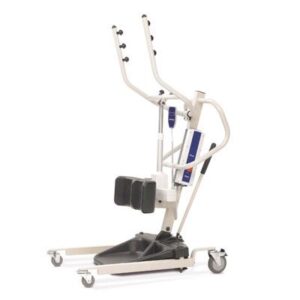Sit to Stand Patient Lifts
Sit-to-stand lifts are easy to maneuver and compact. They are designed especially for patients who have trouble standing up themselves from a seating position. There are a couple of different types of sit-to-stand lifts.
The first is the standard standing hoist which isn’t powered. The second is the more advanced one, powered by technology, the folding, battery-operated, lightweight, portable one. They are a must-have for patients who need support when walking or aid in completing daily activities.
These activities can include using the toilet, dressing, bathing, or moving from a seated position to a standing one. Often referred to as a “Stand-Assist Lift,” this tool is perfect for transferring patients and raising them to a full or partial standing position.
It’s primarily designed to support the upper part of the body, which is why patients who use sit-to-stand lifts have to bear at least some weight. Other names for this convenient tool are “Sara Lifts” and “Stand Up Lifts.”
These devices greatly assist patients in mobility, help them maintain greater independence, and get transferred more safely. Still being able to bear some weight, these patients become able to stand without falling and thus feel more secure.
How does a sit-to-stand lift work?
Unlike manual patient lifts, sit-to-stand lifts usually have a much smaller base and can therefore fit under low beds or go through tight places with the right maneuvering. They’re highly durable and stable and almost always feature wheels under the base.
Not much force is required to push or pull them. The patient’s upper body is supported by a string or a strap, or both, unlike conventional floor lifts where slings are used to maintain the entire patient’s weight.
A sit-to-stand lift supports only the upper body part, while the patient’s legs transmit the rest of the weight to the lift’s platform. The legs must always be securely placed on the platform with a knee block against the knees to prevent them from bending.
A sit-to-stand lift can either be powered by a battery or hydraulic. The battery-powered ones are more innovative and will alert the user whenever there’s not enough power to transfer the patient safely.
What are the benefits of standing lifts, and who can use them?
One of the greatest benefits of standing lifts is the reduction of injuries for patients who need aid standing up. The risk of injury occurrences is greatly reduced with manual patient lifts that caregivers provide with these tools.
Second, these devices promote greater independence for patients, help rehabilitate and strengthen them. For some patients, the very act of standing up can greatly promote their overall well-being, help them regain their strength, and be able to control and balance their weight-bearing abilities.
Some models of sit-to-stand lifts even offer support for walking, offering individuals to engage with the world again by learning to walk anew. With just one device, a patient can be quickly transferred between two seated surfaces.
As already mentioned above, sit-to-stand lifts are only for patients who can bear some of their weight, can sit without assistance, have neck and head control, and put pressure on their legs when they are standing.
A patient should also be able to sit on the edge of a bed without or with some assistance. In a nutshell, these transfer tools require some mobility from the patient, while straps and slings of the lift will completely firmly secure the rest.
For risk-free and comfortable patient transfer, look for your suitable sit-to-stand lift at ReMED today.






